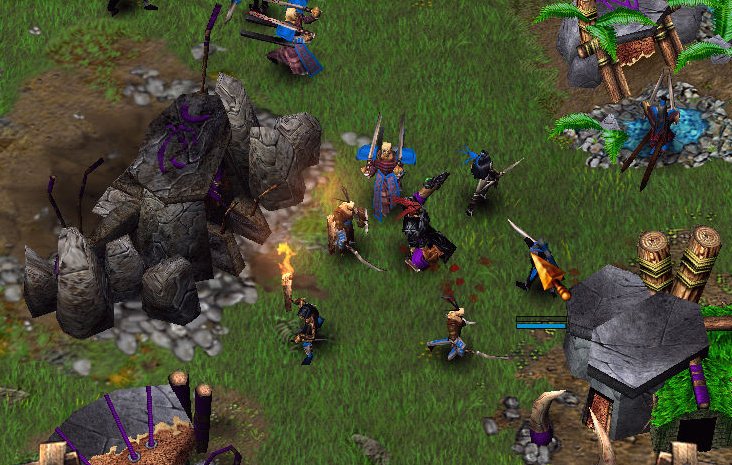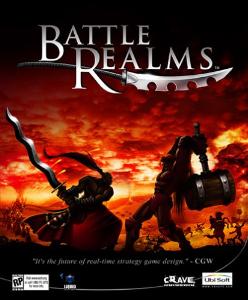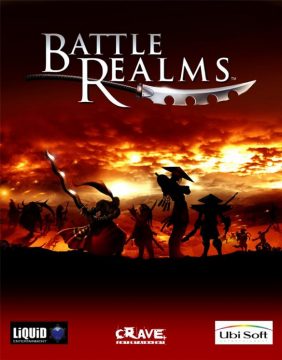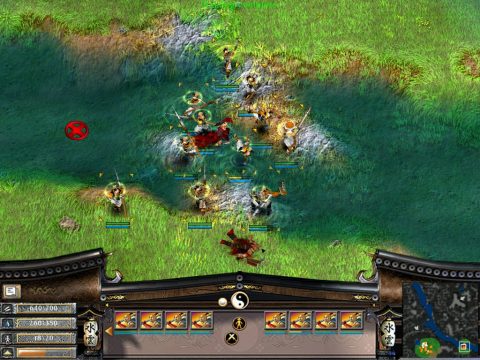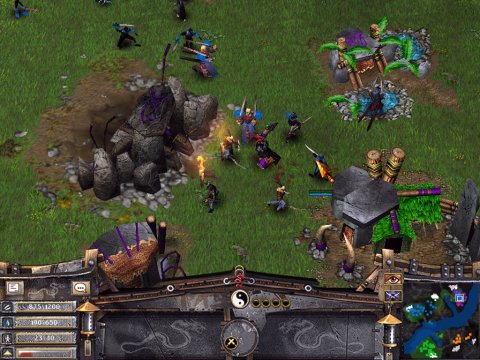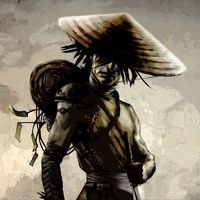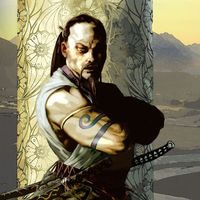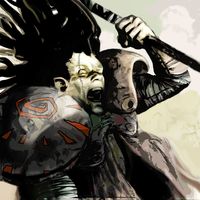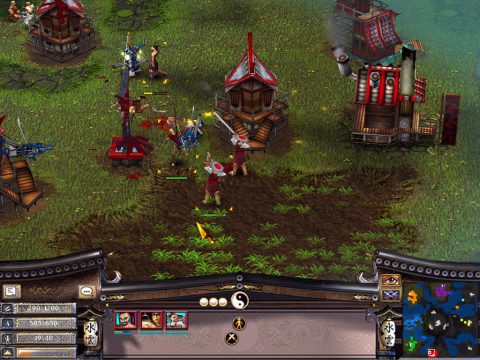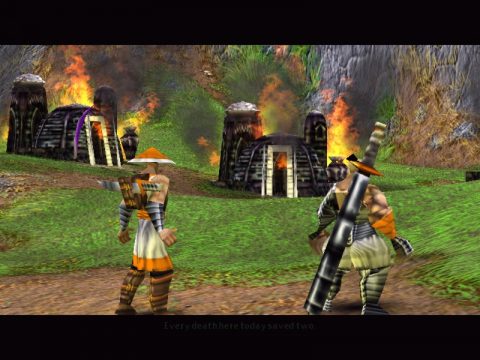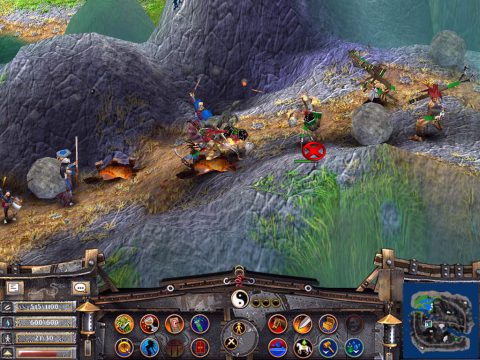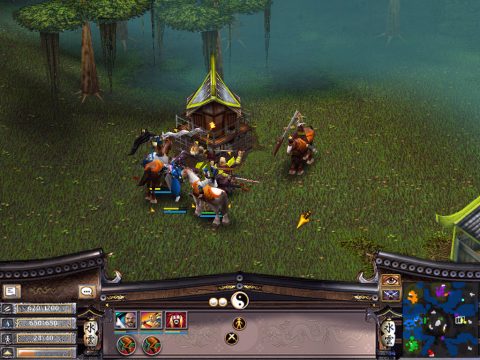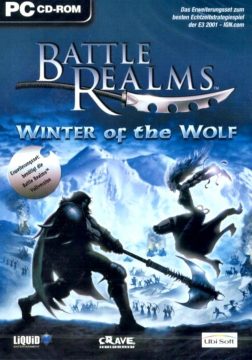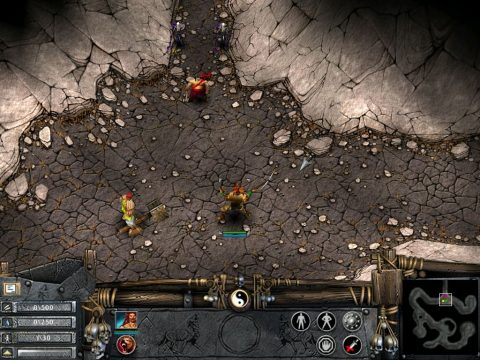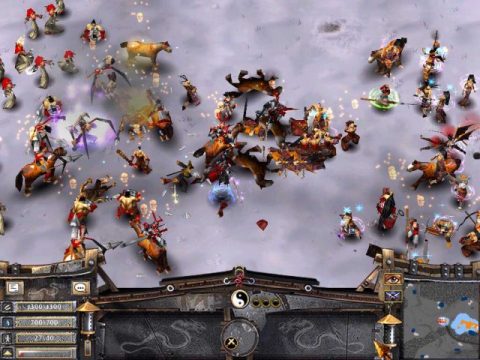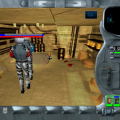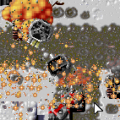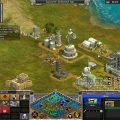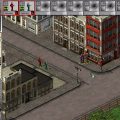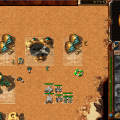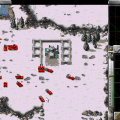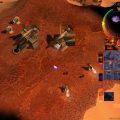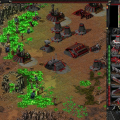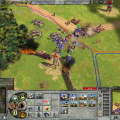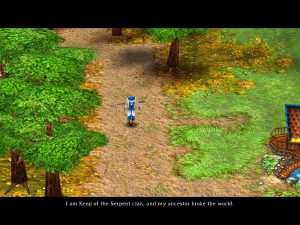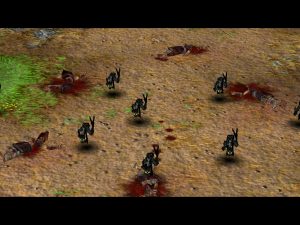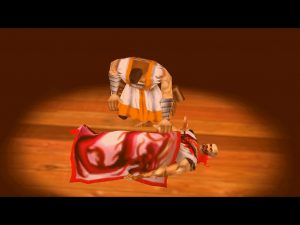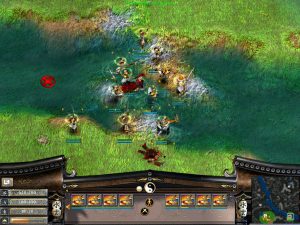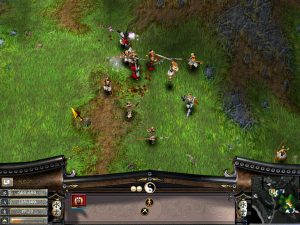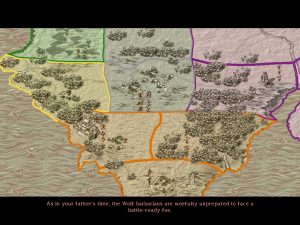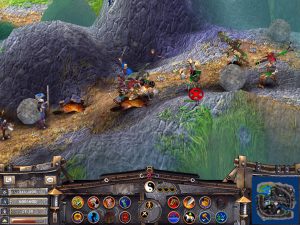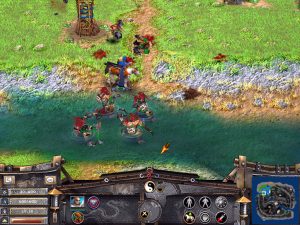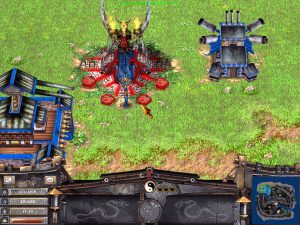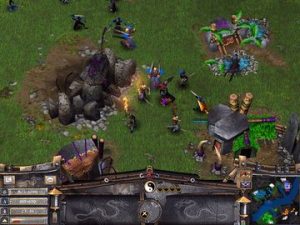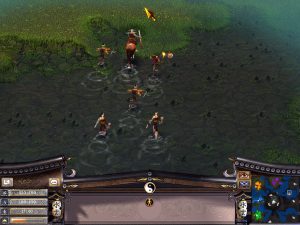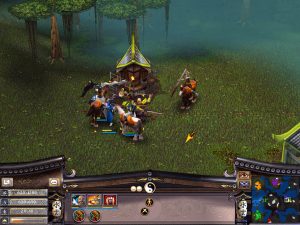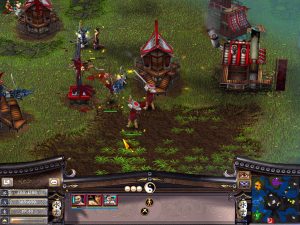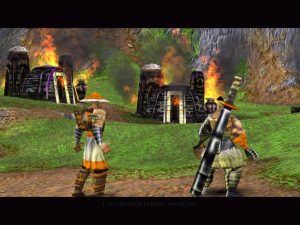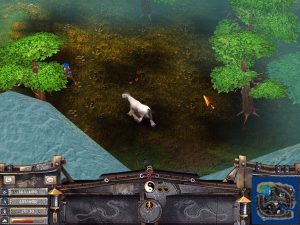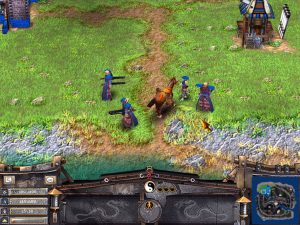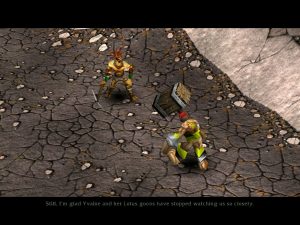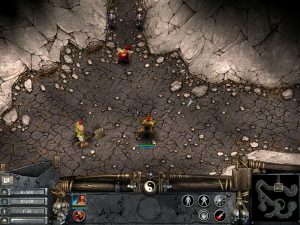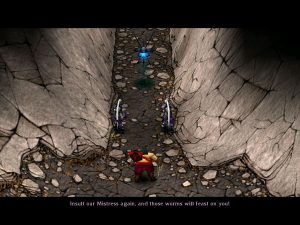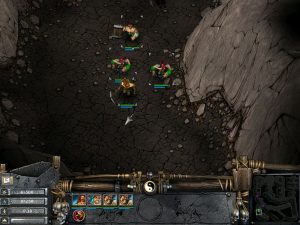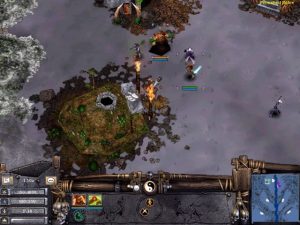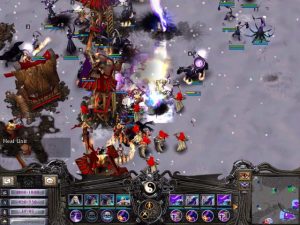It’s easy to put a name on famous game designers when they worked on action, platform or adventure games. But what about real-time strategy games? Total Annihilation‘s Chris Taylor and that’s probably about it.
So let’s talk about Ed Del Castillo for a bit. A member of the industry whose had extensive experience with RTS games, he had started working on them before the label itself was coined. He entered the industry by working on Siege (Mindcraft, 1991, IBM), a strategy game in real time elements, which came out a few months before the classic Dune II. A few years later, he became the 42nd employee of Westwood Studios and a producer inside the studio. His resume also includes working on Alpha Centauri at Firaxis and later (trying) to save Ultima IX in a year. A bit disappointed by the situation at Origin, he ended up creating his own studio in 1999, Liquid Entertainment.
Shockingly enough, the brand new studio’s first game was an RTS. While not as deep as Myth: The Fallen Lords, Battle Realms still heavily relies on an unusual setting. A very long time ago, an unstoppable monstrous race called “The Horde” threatened to destroy the realm of Man. Tarrant the elder, lord of the Dragon Clan, used his most sacred treasure, smartly called “The Dragon Orb”, to destroy the shadow race. The orb was a gift from the Dragon God himself, and held tremendous power. While successful in repelling the horde, there were dire consequences. The continent was shattered in two and the now-scattered Dragon Clan lost its integrity, becoming the shadow of its former self, now known as the Serpent Clan.
The two other clans also had to pay for Tarrant’s choice. Living peacefully on an island, the Lotus Clan was almost decimated by remnants of the horde. To survive, the clan followed a forbidden magic path, gaining tremendous powers in the process. With their home destroyed, they rebuilt their tribe on the former lands of the Dragon Clan. While safe from the Horde, the Wolf Clan was harassed by storms unleashed the Dragon God, infuriated by the disappearance of his own clan. Fortunately, the nature-loving people had their own god, the white wolf, which also gave an artifact to his own: the white wolf skull. Praying to their relic, the wolves were also teleported to the former Dragon Clan lands. The Lotus and the Serpent Clans welcomed them, sharing their lands with the refugees… or so it seemed. Indeed, the Serpent had made a secret pact with the Lotus, allowing the latter to enslave the Wolf Clan and make them toil in their mines. After a few generations, Grayback, the leader of the Wolf Clan, sparked a revolution and freed his people.
Coming back from an eight-year long exile for an unproven parricide, Kenji, heir to the Serpent Clan, discovers his lands are in great turmoil. The death of his father, Lord Oja, left other clans and minor warlords tearing apart the once glorious lands of his people. The game starts with one simple but important choice, where he finds peasants are being harassed by Serpent Clan raiders. If Kenji saves the peasants, he will end up restoring the Dragon Clan. On the other hand, if he decides to murder them, Kenji will become the de facto leader of the wicked Serpent Clan. The faction, the allies and the story will end up being completely different. For example, the obvious traitor will not have the same identity. The only thing that doesn’t change is the pitch of the game – you will need to fight the other clans in order to assure supremacy over the land. Of course, the backstory is pretty important and the murder of Lord Oja, the disappearance of the Dragon Orb and The Horde itself will play an important part.
As one can guess, Battle Realms relies heavily on story. Voiced cutscenes introduce and conclude every mission, and many characters will join you or fight you. Contrary to Command & Conquer, these cutscenes are made with the game engine, which haven’t aged very well. The story is good enough to keep you playing, but the voice actors tend to overdo it, especially with the Asian accents.
Four characters represent each of the main clans. While many heroes & villains are encountered throughout the campaign, the leaders get the most spotlight. Following the path of the Dragon or the path of Serpent can change their role and attitude.
Characters
Kenji
The self-exiled son of the Serpent Clan leader and the hero of Battle Realms. If you join Otomo, his father’s adviser, Kenji will turn into a proud and typical Japanese daimyo, with a nice white kimono. The main enemy of the campaign will be the Lotus. On the other hand, if you murder all the peasants in the first mission, Kenji will keep his exiled outfit and join the Serpent. Unfortunately, he will also adopt a smug and cackling attitude, which gets tedious very fast. The main enemy being this time the Wolf. Keeping Kenji alive is a sine-qua-non condition in every mission. His Battle-Gear doubles the damage of his next attack. Since Kenji’s great defense and impressive strength makes him pretty much the best unit of the game. How appropriate for a main character.
Shinja
Lord’s Oda former lieutenant, becoming de facto leader of the Serpent Clan. After his Lord’s death, he started resenting honor and all the nice thing inherited from the Dragon clan. Eventually, his forces became more or less bandits and pillagers…until Kenji returned. Shinja will join you in both paths around the third mission. Strangely enough, his loyalty will be total in the treacherous Serpent path, while questionable with the Dragon one. Go figure. Shinja’s twin blades are poisoned, making enemies lose health over time. His Battle-Gear intimidates enemies and reduces their strength. Shinja would be a great unit IF he didn’t stop hitting after each attack. In the end, if you use him, you need to keep an eye on him all the time. A shame.
Grayback
Fantasy (Asian or not) would not be complete without the nature-friendly berserker. Grayback is the leader of the Wolf Clan and carries a hulkish pickaxe. A former slave of the mines of the Lotus Clan, he escaped, found the white wolf’s totem, started a rebellion and eventually murdered Zymeth’s lover. Needless to say he doesn’t get along well with his neighbors. He is the only clan leader unconcerned with dominion. Greyback is only trying to send back his clan to their homeland, and he intends to use the power of the Serpent Orb to do that. Greyback has a ton of health points and, like every Wolf unit, can smash buildings at an alarming rate. His Battle-Gear is the same as the zen warrior Otomo – a big battle cry making all the allies more dangerous.
Zymeth
Looking at the picture on the left, it will come as no surprise to you to learn that Zymeth is… kind of evil. His clan is afflicted by a powerful disease known as “the corruption”, which will eventually destroy the whole clan. For this reason, he has been trying to get his hands on the Serpent Orb for a long time. He acts as the main bad guy in the Dragon path. He is the only non-playable hero in single-player, so maybe that’s why he is so pissed? While pretty frail, Zymeth has awesome powers. His Battle-Gear lets him summon a storm with two main effects – stricking down enemies with lightning and accelerating rice harvests. Watch out though, the Stamina cost is high. A good technique in multiplayer consists in putting him on a watchtower to protect your base.
The campaign is comprised of 12 missions for both the Dragon and the Serpent. Like in Command & Conquer and Dune II, you will be able to pick your next mission from two or three choices. Some missions are mandatory though. The AI tends to be extremely cunning, and the more you progress through the campaign, the harder it gets. The endgame is incredibly brutal as the AI becomes relentless and might stop you from finish the game. It doesn’t really help that the missions take more and more time to complete.
So, what makes Battle Realms different from big names of the time, like Starcraft or Age of Empires II? First and foremost, you don’t build units. Peasants pop out of your town-hall on a regular basis. The more units you have, the slower the peasants come out. The frequency changes according to your actual population, accelerating after each carnage and stopping once the cap is reached. Peasants can fight and harvest rice and water, the two resources of Battle Realms. Water has an extra effect since it can heal your units and refill their stamina bar, used for activating Batte-Gears and running. Peasants can of course build and repair buildings.
Like in Starcraft, the peasants can also evolve into new units by training in specific buildings. The difference with Blizzard’s mammoth is that peasants can train up to three times, turning them each time in a new and deadlier unit. Let’s take the example of a Dragon Peasant: train him in the dojo (melee building), and he will become a spearman at first. Then train this Spearman in an Alchemist hut (magic building), and he will turn into a deadly Kabuki Warrior. If you really want to go on steroids, make the Kabuki Warrior enter the target range (self-explanatory) and you’ll finally get a badass Samurai warrior. Of course, you can do it in any order you want. And of course, every training requires water, rice & time.
Training all your units in order to powerplay isn’t a smart move. Battle Realms applies a “rock-paper-scissors” system rules, meaning that even your most powerful unit might be threatened by a certain type of damage. There are six types of damage: piercing, cutting, blunt, explosive, magic or fire. So for example, your badass Samurai might launch deadly cutting and piercings attacks but explosives will hurt him a lot. A classic way of reinforcing your base or advanced units is getting new stamina draining abilities called Battle-Gears. More than simple upgrades, they really are a game-changer. For example, simple Archers will gain fire arrows and therefore burn buildings down very fast. As expected, Battle-Gears cost some resources but also Yin and/or Yang, the other proper mechanic of Battle Realms.
Yin and Yang are resources acquired through sheer battle. They act as the morality counter for your clan: good guys (Dragon & Wolf) get Yang, bad guys (Lotus & Serpent) have Yin. Anyway, the more units you slay or the more damage you deal, the more Yin/Yang points you will get. Distance from the base is also a factor in getting more Ying/Yang: the further your army is from allies building, the faster the points will appear. Once you get them (up to a maximum of eight), you can keep them to give a passive bonus to your units or spend them. But you will eventually use them as a resource to buy Battle-Gears or to buy certain units (like the ninja). The Dragon and the Lotus also have a unique use for Yin/Yang points.
Now that we have cover the basics, let’s talk about the clans themselves:
Clans
Dragon (Orange)
The easiest clan to begin with. Proud warriors obsessed with honor and weapon mastery. Their design is very reminiscent of the Heian period. They are extremely versatile and most of the units have a great resistance to fire. Contrary to the other clans, they don’t have a tier IV unit. Instead, they get a Dragon Shrine, which can summon an extremely powerful attack. It’s pretty similar to the “nuclear launch” of Red Alert fame. While this sounds awesome on paper, it’s pretty expensive to activate (Yang points + unit sacrifices). Furthermore, it doesn’t affect buildings and the AI disperses its units fast. Still, the Dragon Clan possesses the awesome Kabuki Warrior, who can stunlock and lower resistances of surrounding enemies.
Serpent (Red)
The guys you always want to kill first. These are degenerate bandits and raiders who can get annoying in early game. Their design is mostly Sengoku revamp. The Serpent specialize in hit & run techniques. While not as strong as the other clans, it acquires excellent range units such as the Musketeer and their tech tree offer many debuffs. For example, the Swordsman’s first Battle-Gear allows him to steal nearby enemies’ BG. Sharing the love, Raiders can easily burn down buildings and rice fields. Contrary to the Orcs of Warcraft III, they still have an edge during end game with their Tier IV unit: the Necromancer. As his name implies, he can summon Spirit Warriors and Zombies. Besides, he is a great close combat fighter.
Wolf (Green)
Since they are the main campaign path, Serpent and Dragons are relatively similar in terms of units and balance. The red-haired Wolf clan on the other hand is where things start to get crazy. First, the nature-friendly clan has almost no healers but all the units can regenerate (super fast if you buy the right tech). Second, they don’t buy Battle-Gears but instead get blessings at a shrine. Those blessings must be channeled by a strong unit called the Druidess, who will bless nearby allies. A Wolf unit can get a shale armor at a specific building, making her much harder to kill, but blessings won’t affect her anymore. Third, they kill horses to raise pack of wolves. Pack Masters can tame three wolves at a time, which is perfect for hunting enemiy scouts. Otherwise, the clan is expert in melee and have some funny abilities like turning units into werewolves.
Lotus (Purple)
The bad guys of the game really want to look evil. Getting their clothes from the cenobites dressing room, they look gross and vaguely undead. The Lotus Clan draws it strength from “The Tree of Corruption”, an ancient Yin artifact. The tree was protected by three brothers, who acted as the protectors of the clan. Like the Druidess, you can summon each brother to bless Lotus units with Battle-Gears for one Yin point. Instead of praying, these three ghosts refill their stamina by draining enemies extremely fast. The corruption gnawing at the clan gives it tremendous powers. Lotus have Kamikaze Troopers, poisonous worm-infested units. And last but not least are the Warlocks. Their magic attacks are devastating and really make the Lotus a unique clan. The huge drawback of playing Lotus is that units have zero resistance against piercing damage, so enemies’ Archers should be avoided at all cost.
Clans also have unique “Zen Masters”, who act as super units. While they can be summoned or resurrected with Yin/Yang points, they are not as powerful as Warcraft III‘s heroes. Leaving a Zen Master against five enemies is clearly a death wish. In the campaign, you can get them either automatically (Shinja, Otomo) or by fulfilling specific conditions. Their Battle-Gears are much more powerful than other units as they can summon minions or give buffs to nearby units. Since summoning them cost Yin/Yang points in multiplayer, you have to choose wisely and to create proper strategies according to their abilities.
Terrain also play a pretty big role in Battle Realms. As you can see on the screenshots, the fog of war is pretty thick but that’s not all. You can hide your units in the forest, making them harder to detect for faraway units. Use of height and Watchtowers also give your range units a clear advantage. Fire also plays a part as it can spread to buildings, trees and even rice fields, disrupting harvests. Lastly, wild horses run through the maps. You can tame them in order to turn most of your units into cavalry. A mounted unit gains a new stomping attack, more health and rides very fast through the environment.
The graphics are colorful, units each have a distinctive look and every clan feel completely different even if, in theory, they have the same tier evolution and the same tech progression. Units are well animated, each having its own idle animation. The cartoony style has aged well. On a technical side, the game runs flawlessly on Windows Vista/7 but the vanilla resolution is locked to 1028×768.
Strangely enough, the biggest problem of Battle Realms resides in its main strength: management. At the start of a mission, Peasants are popping all over your base and that’s great. But when you reach endgame and prepare for a large scale assault, it can get troublesome. If your army dies, you get a ton of Yin/Yang points but you are also left with barely any peasants and rebuilding your army will tax your resource harvest. For a game conceived as fast-paced, you end up waiting for the enemy attack in order to make a decisive counter-attack you are 100% sure to win.
Battle Realms is a gem for anyone who love classic RTS games. It offers a great challenge in a unusual setting with unique units and interesting features. It also paved a way to a different approach of RTS, with a heavy focus on micromanagement and skirmish. Going for the top tier units isn’t rewarded, “Zerg rushing” isn’t rewarded – you need to mix different types of units, you need to organize raids, etc. In a sense, while feeling “old school” with some mechanics and the interface, Battle Realms appears like the avant-garde of recent games like Dawn of War or Company of Heroes, focusing on units rather than on the army as a whole.
Battle Realms: Winter of the Wolf – Windows (2002)
Battle Realms received much praised from the critics and the public, giving way one year later to an expansion pack called Winter of the Wolf. As you can guess, the game focuses on the Wolf Clan. Taking place seven years before the return of Kenji, the campaign retells the story of Grayback. Enslaved in the shale mines of the Lotus Clan, the young wolf leader secretly trains his brethren in the art of war, waiting for the right opportunity. Sent by Yvaine, Zymeth’s mistress, in the depths of the mines, Grayback acquires the power of Grayskull, the White Wolf Skull, and starts his little revolution. Through 12 missions, your objective will be to slay Yvaine and guide the clan towards freedom.
The campaign is much more tedious than Battle Realms‘, thanks to the excruciating start. You spend the first missions in the mines of Lotus Clan. It’s a very slow beginning, where you only control Grayback and a few units. It consists of unending underground corridors, fighting giant spiders and backtracking to get long and tedious cutscenes. Once outside, it gets much better. Winter has come for the clans of Battle Realms and plays a major role. From time to time, snow storms will freeze rice fields and slow down harvesting. The new mountain environments are quite nice.
The expansion pack has and probably always will be linked to the RTS genre. Its main quality is to offer new content to multiplayer. To comply, Winter of the Wolf offers to each clan two new units, one new Zen Master and a new building. It also adjusts game balance, adds a ton of mulitplayer maps and fixes some clunky elements of the interface. A typical expansion pack for sure.
Winter of the Wolf doesn’t really add much to the original game. Chances are you might play it only because it was bundled in re-releases of the game by Ubi Soft. It’s also part of the GOG rebuild. The expansion pack came out in November 2002, after Warcraft III‘s and Age of Mythology‘s releases. It suffered heavily from the comparison and most players forgot about Battle Realms. A damn shame.
Liquid Entertainment have been working on two iOS / Android projects for Battle Realms: a version of the original game for those platforms and a completely new title called “Genesis”, a card game. While using the featured gimmicks of the series (Battle Gears, Evolutionary units, clans), its aim is to expand the mythos of the series by explaining the genesis of the various clans. The only media release was a wallpaper featuring mythical creatures with pointy ears and such. No public announcement has been made after the wallpaper release in 2012.
